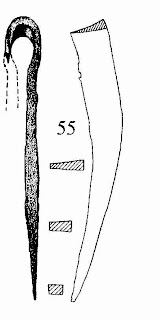Sometimes you want to know exactly how a piece
of furniture is constructed. Not only the front or the (in)sides of a chest,
but the back and the bottom as well. The fun of having a digital
camera is that it allows you to see these otherwise unrevealed pieces of
information. You just point your camera to the spot you want to see and click.
It automatically adjusts the lighting, diaphragm and shoots a perfect photo for
you, although it might take a few tries to get a nice shot. Then you only have
to look at the display to have the side of the furniture piece revealed to you that
was once hidden from sight.
Using this “shoot first, have a look later”
approach sometimes gave surprising results, as will be shown by the following
examples.
A 14th century chest from Kloster Isenhagen
Chest TR-NR-409 / ISN Ba 83 from Kloster Isenhagen
This relatively small hutch type chest made of oak stands
in a corner of the Chapter house in Kloster Isenhagen. It is dated
dendrochronologically around 1375. On the left of the lockplate the initials L E H are
burned, which were the initials of the nun who once owned the chest. Directly beneath the lock the initials K I are found, which stand for Kloster Isenhagen. The hutch
is made in oak in the Braunschweiger construction style (see K.H. von
Stulpnagel –Die gotischen Truhen der Lunenburger Heidekloster for more details
on this construction type). Inside the chest is a small drawer. The lid is
fastened with iron hinges and decorative iron nails are found on the front of
the chest. The lock with lock-hinge is still complete. Height of the chest is 69 cm, width 85
cm and depth 53.7 cm. (TR-NR-409 / ISN Ba 83).
The arrows show the small marks LEH on the left and the large marks K I below the lock plate.
The side of the chest showing part of the iron thorn hinge.
The thickness of the planks used for construction varies between 3.5 and 4.5 cm.
The top of the chest showing the iron strips.
Aside from the ubiquitous spider webs, our
camera spotted at the underside of the bottom an extra wooden rail which
supported the bottom planks.
The underside of the chest with spiderwebs. The thickness of the bottom planks is 2 cm.
A medieval chest from the open air museum in Hosseringen
This is a hutch type chest made of oak of around 1495
(dendrochronologically) comes originally from Bohlsen, but is now standing in the open air museum in Hosseringen
in a large farm from Lower Saxony. It was found in 1978 in a shed, and has
the marks and repairs of an extended use. At the backside, one of the legs is
replaced by a forked stem, which is nailed to the chest. The front of the chest
shows a large hole, and one of the sides has a wooden rail hanging on one nail.
The lock, however, looks remarkably good. The lid of the chest has two “four-pass”
carvings, which found on other medieval chests as well, e.g. the 'travelling chest' of
the abbess of Isenhagen. Height of the chest is 86.05 cm, width 175.05 cm and depth 76 cm.
The two sides of the chest, showing that quite some parts are in disrepair.
The replaced leg of the chest.
Taking an photo from the underside was a surprise. The
chest did not have a bottom at all! The photo directly shows the underside of
the lid and the inside of the chest. The lid is reinforced by two added rails
that are nailed to it. You can also see the grooves where the side drawer was
located.
The inside of the chest shown from beneath: a reinforcement of the lid by two added rails.
A medieval chest from the church in Süderburg
The church of St. Remigius in Süderburg houses
a heavy iron-bound medieval chest dating from 1303. It is now used as an almonry.
Such chests were often used as archive-chests, and could with use of the rings
and rope easily be transported to safety in case of calamity. There was only
one way to have the camera have a look at the underside of the chest, and that
was to turn it over (no-one else was in the church, thus no-one objected…).
The chest from above showing the hole for the coins as well as a large ring on the middle iron band.
Two rings for carrying the chest are on the side of the chest.
The front lock is open, but one side has an additional modern padlock.
Now there happened to be a large hole in the bottom of the chest! Once crudely hacked to steal the coin, or provide an anchor for the chain that held the chest to a pillar of the church? Who knows … The church records mention that the chest has been forcibly opened in 1557, 1562 and 1588. However, what you can notice from the hole is the immense thickness of the oak planks used to build the chest.
Robbery! A hole hacked in the bottom of the chest.
The shoot first, look later approach was also used on the stone church tower. This used to be part of a medieval castle, but was reused in 1370 as a church tower. Inside the tower a free-standing wooden clock-tower stands. Of course, this could only be seen by the camera peeping through a hole.
The church tower of Suderburg and a part of the wooden clocktower built inside the stone church tower.


























































